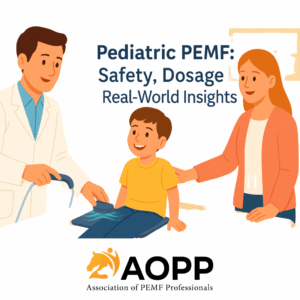
Why Parents & Practitioners Are Asking About PEMF for Kids
From growing-pains and ankle sprains to sleep struggles and focus issues, today’s children face many of the same musculoskeletal and neuro-behavioral challenges as adults—just in smaller bodies. Pulsed Electromagnetic Field (PEMF) therapy is drawing interest because it delivers non-invasive, low-frequency magnetic pulses that nudge cells back toward healthy electrical balance. Research in adolescent bone healing, pediatric sleep, and attention disorders suggests benefits with a strong safety profile, sparking demand for child-specific guidance. (pmc.ncbi.nlm.nih.gov)
The Science of Safety
| Key Point | What It Means for Kids |
|---|---|
| Non-ionizing & non-thermal | PEMF fields used therapeutically stay well below the energy needed to break chemical bonds or heat tissue. |
| Membrane-level action | Signals modulate calcium channels and nitric-oxide pathways, supporting circulation and tissue repair without altering DNA. |
| Clinical track record | Decades of orthopedic use show high union rates and few adverse events—even in patients under 18. (pmc.ncbi.nlm.nih.gov, onlinelibrary.wiley.com) |
Reported side-effects are rare and mild—transient restlessness, tingling, or slight warmth at the coil site dissipate quickly. No growth-plate damage or developmental delays have been documented in peer-reviewed literature to date. Nevertheless, AOPP recommends medical clearance before treating children who have:
- Implanted pumps, programmable shunts, or pacemakers
- Uncontrolled seizure disorders
- Unexplained genetic syndromes or metabolic bone disease
Parental supervision and signed consent are essential for every session.
Right-Sized Dosing for Growing Bodies
Core Principles
- Start Low, Go Slow – Children’s higher surface-area-to-mass ratios mean lower field strengths can achieve therapeutic currents.
- Shorter Sessions First – Allow tissues to acclimate and watch for response cues (sleep quality, pain scores, mood).
- Progress by Minutes, Not Intensity – Increase exposure time before jumping to stronger Gauss levels unless under clinical direction.
Illustrative Pediatric Dosing Matrix
| Age Range | Field Intensity* | Session Length | Weekly Frequency | Notes |
|---|---|---|---|---|
| 4-6 yrs | 200 – 500 G | 5-8 min | 2-3× | Always supervised |
| 7-12 yrs | 400 – 800 G | 8-10 min | 3× | Add 1 min every 2 wks if well-tolerated |
| 13-17 yrs | 800 – 1200 G | 10-15 min | 3-4× | May reach adult dose in 6-8 wks |
*Gauss (G) values refer to coil face output; always verify your device’s calibration.
When to Adjust
- Scale up if the child reports lighter pain, easier movement, or better sleep for ≥48 h post-session.
- Scale down or pause if hyperactivity, headache, or skin warmth persist beyond 30 min.
Real-World Case Snapshots
| Case | Protocol | Outcome |
|---|---|---|
| 8-year-old soccer player – acute ankle sprain | 600 G • 8 min • 6 sessions over 10 days | Cleared to play in 10 days vs. 16-day team average. Parent noted “half the usual swelling.” (mdpi.com) |
| 10-year-old with ADHD-related insomnia | 300 G mat at bedtime • 7 min nightly for 3 wks | Sleep latency cut from 45 → 20 min; teacher reported “better morning focus.” (drroseann.com) |
| 15-year-old post-orthodontic pain | 900 G handheld • 5 min bilaterally | Pain score dropped from 6 → 2 within 24 h; no NSAIDs needed. |
(Case data courtesy of AOPP member clinics; individual results vary.)
Frequently Asked Questions
“Will PEMF stunt my child’s growth?”
No evidence links therapeutic PEMF to inhibited bone growth; studies in adolescent fracture healing show neutral or positive effects on union and density. (pmc.ncbi.nlm.nih.gov)
“Kids say they don’t feel anything—does that mean it isn’t working?”
PEMF is sub-sensory for most users. Look for functional markers (mobility, pain scores, sleep) rather than subjective tingling.
“Is higher intensity always better?”
Not in pediatrics. Cell membranes reach peak responsiveness at surprisingly low field strengths. Overshooting can induce temporary agitation without added benefit.
Key Takeaways
- Strong Safety Signal – Decades of orthopedic and neuro-behavioral use show minimal risks when contraindications are respected.
- Child-Scaled Dosing Works – Lower intensities and shorter sessions deliver therapeutic gains without over-stimulating young tissues.
- Evidence Is Growing – Real-world cases and emerging studies point to faster recovery, better sleep, and improved focus in youth.
Share this article with parents, coaches, and clinicians who care for “little patients with big questions”—and stay tuned as AOPP continues to map the frontier of pediatric PEMF therapy.
